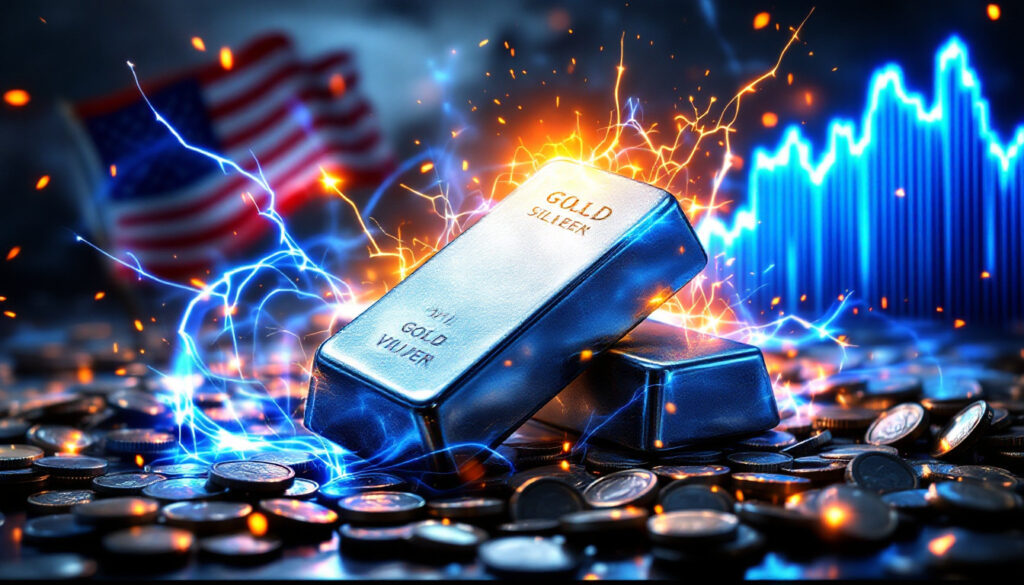Silver Market Chaos: Understanding the Current Upheaval and Future Implications
The silver market is currently experiencing unprecedented volatility, with prices surging amidst technical breakouts and unusual market conditions. Silver has risen 3.35% to $32.32, outperforming most metals in the complex while gold reaches new record highs of $3,246.80. This remarkable price action comes after a brief correction related to global tariff impact on commodities, demonstrating silver's resilience and growing appeal to investors seeking both safe haven assets and industrial exposure.
The metal's technical strength is evident as it breaks above critical resistance levels, establishing a foundation for potential continued upward momentum while unique market conditions like backwardation signal intense physical demand that could reshape traditional market dynamics.
What's Causing the Current Silver Market Chaos?
Recent Price Action and Technical Strength
Silver's 3.35% rise to $32.32 represents significant outperformance compared to other metals, occurring simultaneously as gold establishes new records approaching the $3,300 mark. This recovery follows a recent correction triggered by market reactions to global tariff announcements, demonstrating silver's inherent volatility and responsiveness to macroeconomic factors.
The breakthrough above the critical $31.45 level is particularly noteworthy, as technical analysts widely consider this a bullish signal that could invite further buying. This price point represents the 50% retracement level of a key trading range, making it especially significant for market participants utilizing Fibonacci analysis.
Currently trading above the 200-day moving average of $30.92, silver has established immediate technical support that should serve as a foundation for potential future price action. This technical positioning suggests that downward moves may represent buying opportunities rather than the beginning of prolonged weakness.
Backwardation: A Key Indicator of Physical Demand
One of the most telling indicators of silver market disruption is the increasing backwardation observed in futures contracts. This unusual market condition occurs when future prices are lower than spot prices, contradicting the normal market state where futures typically trade at a premium to account for storage costs and interest rates.
Backwardation signals exceptionally strong demand for physical metal, as buyers demonstrate willingness to pay premium prices for immediate delivery rather than waiting for future settlement. This phenomenon highlights potential physical supply constraints that paper market mechanisms struggle to address.
Similar backwardation patterns are also appearing in the platinum market, suggesting a broader trend of physical precious metals outlook across multiple markets. This correlation reinforces the significance of the current market anomaly.
Physical buyers are effectively absorbing selling pressure that appears in futures markets, creating what analysts describe as a "natural silver squeeze" driven by fundamental market forces rather than coordinated buying campaigns seen in previous market episodes.
How Are Market Dynamics Shifting in Silver?
Short Positions and Market Pressure
A dramatic increase in short positions has created unusual tension in the silver market. Institutional traders betting against silver price increases have established significant positions, yet physical demand continues to strengthen, creating a potentially explosive market imbalance.
The combination of increased short positions and persistent backwardation creates particularly chaotic market conditions. When physical demand potentially overwhelms paper market positioning, short sellers may be forced to cover their positions by purchasing silver, potentially accelerating price increases.
This market structure is showing signs of what could develop into a natural supply squeeze through organic market forces rather than coordinated investment campaigns. Unlike previous "silver squeeze" events organized through social media, current conditions appear to be driven by fundamental supply and demand factors.
Some market analysts have begun referring to the current conditions as the foundation for a potential "Silver Squeeze 2.0", suggesting that market forces rather than retail investor coordination may drive the next significant price movement.
Dollar Weakness and Precious Metal Performance
The US Dollar Index has fallen below the critical 100 level, currently trading at 99.87, representing a decline of 0.8565% against other major currencies. This dollar weakness provides a significant tailwind for silver prices, as commodities priced in dollars become more affordable for international buyers.
Silver has already reached record highs in many currencies worldwide, highlighting its global appeal as both an industrial input and monetary asset. Currency devaluation concerns continue driving interest in precious metals as wealth preservation vehicles.
Current market behavior suggests silver is functioning more as a precious metal than an industrial metal, with investors prioritizing its historical role as a store of value during times of currency uncertainty and geopolitical instability.
Dollar weakness appears to be a structural rather than temporary phenomenon, with multiple factors including fiscal deficits, debt levels, and changing international trade settlement patterns contributing to declining confidence in the US currency.
What External Factors Are Influencing Silver Prices?
US-China Trade Tensions and Industrial Demand
Recent escalation in US-China trade relations has introduced a new dimension of uncertainty to silver markets. The US implementation of 145% tariffs on Chinese imports represents a significant increase in trade barriers, with China responding through 125% retaliatory tariffs on US goods.
China stands as a top global importer of silver for industrial applications, particularly in electronics, solar panel manufacturing, and emerging technology sectors. Trade restrictions could potentially disrupt established supply chains and demand patterns.
This trade conflict creates considerable uncertainty for silver's industrial demand outlook, which typically accounts for approximately 50% of annual silver consumption. Market participants are carefully analyzing potential impacts on Chinese manufacturing output and subsequent silver investment trends.
Potential negative impacts on physical silver demand may materialize in coming months as manufacturers adjust to new trade realities and potentially restructure supply chains to accommodate the changing economic landscape.
Potential Offsetting Factors for Industrial Demand
Despite concerns about Chinese industrial demand, several counterbalancing factors could mitigate negative impacts on silver consumption. Increased domestic US production requiring silver inputs may develop as manufacturing potentially relocates due to tariff structures.
Other countries not affected by US tariffs may increase silver imports to fill production gaps created by trade barriers, redistributing rather than eliminating demand. This geographical shift in industrial demand could preserve overall consumption levels while changing traditional trade flows.
China's ongoing trade with nations not directly affected by US tariffs is likely to continue supporting significant silver demand, as Chinese manufacturers maintain production for non-US markets. This diversification of export destinations may insulate portions of Chinese silver demand from direct tariff impacts.
Currently, market participants appear more focused on silver's precious metal characteristics than potential industrial demand concerns, suggesting that monetary demand may temporarily overshadow industrial factors in determining price action.
What Technical Levels Should Silver Investors Watch?
Key Support and Resistance Zones
Silver is currently testing the lower boundary of a short-term retracement zone ranging from $34.59 to $28.31, with particular attention on how prices behave around these technical thresholds. This trading range represents the recent high-low extremes that guide many technical trading strategies.
The 50% retracement level at $31.45 is now acting as support after previously serving as resistance, demonstrating a key technical principle of support/resistance role reversal that often guides price action. Continued trading above this level would reinforce the bullish case.
The 200-day moving average at $30.92 provides additional technical support, representing the type of long-term trend indicator that institutional traders monitor closely when establishing positions. This moving average has historically provided reliable support during silver's uptrends.
Any downward momentum triggered by profit-taking or short-term market disruptions could create buying opportunities for investors seeking to establish or increase silver exposure. Technical analysts generally view pullbacks that hold above key moving averages as potential entry points.
Silver's technical strength is currently being boosted by broader safe-haven demand across precious metals, creating potential for continued correlation with gold market analysis as both metals respond to similar macroeconomic drivers.
Price Action and Trading Strategies
Dollar cost averaging strategies are proving effective in the current volatile market environment, allowing investors to accumulate positions while managing the risk of significant price swings. This approach is particularly suited to silver's historical volatility compared to gold.
Downward price moves that maintain above key technical support levels potentially represent buying opportunities rather than reasons for concern, particularly when fundamental factors remain supportive of higher prices. Many institutional investors view technical corrections as natural market processes.
Traders are closely monitoring price action around major support and resistance areas, with particular attention to volume patterns that may indicate the strength or weakness of price movements. High volume breakouts tend to have more sustainability than low volume price changes.
Technical indicators including the Relative Strength Index (RSI), Moving Average Convergence Divergence (MACD), and stochastic oscillators are suggesting potential for further gains despite silver's recent price appreciation. These momentum indicators remain below overbought territory.
Current price action breaking above key technical resistance levels suggests continuation potential rather than exhaustion, particularly when supported by fundamental factors like backwardation and dollar weakness that provide fundamental justification for higher prices.
FAQ About the Silver Market Chaos
What is backwardation and why is it significant for silver?
Backwardation occurs when spot prices exceed futures prices, indicating exceptionally strong immediate demand for physical metal. This market anomaly contradicts normal conditions where futures typically trade at a premium to spot prices to account for storage costs and interest rates.
In silver markets, backwardation is particularly significant because it suggests buyers are willing to pay premiums for immediate delivery rather than wait for future delivery, potentially signaling physical supply constraints. This condition rarely occurs in efficiently functioning commodity markets.
The persistence of backwardation often precedes significant price movements as it highlights fundamental imbalances between physical demand and available supply that futures markets cannot immediately resolve through normal price discovery mechanisms.
How does inflation affect silver prices?
While official inflation figures show the US dollar is currently losing purchasing power at approximately 2.4% annually (down from previous higher inflation rates), silver's price appreciation is significantly outpacing this devaluation, making it an effective hedge against currency depreciation.
Silver historically performs well during periods of inflation as investors seek tangible assets with intrinsic value rather than holding currency that steadily loses purchasing power. This monetary demand function supplements silver's industrial utility.
Unlike many financial assets, silver cannot be created through monetary policy decisions, giving it particular appeal during periods when central banks engage in expansionary policies that potentially reduce currency value.
The inflation-hedging characteristics of silver become more prominent during periods of financial uncertainty, geopolitical instability, or declining confidence in traditional currency systems and government debt instruments.
What could trigger a "Silver Squeeze 2.0"?
A combination of increasing short positions, deepening backwardation, physical demand outpacing available supply, and persistent dollar weakness could create conditions for a natural market squeeze unlike previous orchestrated buying efforts.
When physical silver buyers absorb available inventory while speculative short positions remain elevated, market dynamics can force short sellers to cover positions by purchasing silver, potentially accelerating price increases through a self-reinforcing cycle.
Unlike previous social media-coordinated purchasing campaigns, current market conditions suggest any potential squeeze would develop through natural market forces reacting to fundamental supply-demand imbalances rather than coordinated investor action.
The industrial component of silver demand provides an additional potential catalyst not present in gold markets, as manufacturers may accelerate purchases to ensure production continuity when supply constraints emerge, further tightening available physical inventory.
How might US-China trade tensions impact silver long-term?
While reduced Chinese imports may initially pressure silver prices through diminished industrial demand, increased domestic production in the US and other nations could partially offset these effects as manufacturing potentially relocates to avoid tariff barriers.
Global trade patterns tend to readjust rather than collapse in response to bilateral tariffs, suggesting silver demand may redistribute geographically rather than significantly decline in aggregate. Non-tariff affected nations may increase silver imports to support manufacturing for export markets.
Silver's precious metal characteristics may temporarily overshadow industrial demand concerns, particularly if economic uncertainty stemming from trade tensions increases investment demand for safe haven assets that traditionally perform well during periods of geopolitical instability.
Long-term silver fundamentals remain supported by technological developments requiring silver inputs, including renewable energy, electric vehicles, and advanced electronics, suggesting industrial demand should recover from any short-term trade disruptions as supply chains adapt to new investment strategies and economic realities.
Interested in Catching the Next Major Mineral Discovery?
Stay ahead of the market with Discovery Alert's proprietary Discovery IQ model, which instantly notifies investors of significant ASX mineral discoveries and transforms complex data into actionable insights. Explore why historic discoveries generate substantial returns by visiting Discovery Alert's dedicated discoveries page and begin your 30-day free trial today.




